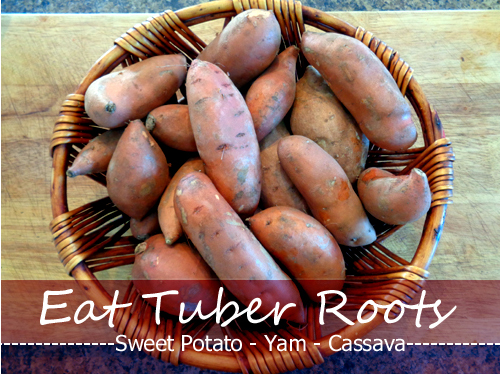Eat Tuber Roots, And Tuber Leaves As Well: Sweet Potato, Yam and Cassava
Tropical tuber roots like the sweet potato, yam and cassava are often eaten as root vegetables but the tuber leaves are just as, if not, even more nutritious, and are never left to waste.
Sweet Potato Tuber
The sweet potato tuber or root is commonly enjoyed by all; though there is a whole lot more of its incredible health benefits than you can dream of. Little do I care for its Vitamin D content in face of the abundant sunlight over here; though I am happy that it takes care of my bones, teeth, skin and heart.
Greater, then, is my joy to discover its Vitamin C that produces collagen for a beautiful skin. As a good source of magnesium and iron, the sweet potato is a comfort food that helps you to de-stress, as it keeps your system in tiptop condition to avoid disease.
Steamed sweet potatoes of a combined orange and purple color, make a most delightful, nutritious snack. Such dual-colored tubers can only be found in some remote rural markets in Sabah.
Further, boiling will leach out the antioxidants into the water: anthocyanin from the purple cubed roots; and carotenoids, from the orange ones; this way, I make my sweet potato dessert soup.
Sweet Potato Leaves
It is noted that sweet potato leaves are a good source of vitamins, minerals, antioxidants, dietary fiber, and essential fatty acids. These tuber leaves improve your immune function, reduce cell damage by free radicals, as well as heart disease risk, and stop cancer cell growth.
Stir-fried with garlic and soy bean paste, sweet potato leaves and the peeled stems, together make a rice meal more satisfying and nutritious. Once considered as the poor man’s vegetable, sweet potato leaves are increasingly in demand in the western countries nowadays.
Yam Tuber
The mild flavored yam, on the other hand, is relatively less nutritious than the sweet potato although it is a wholesome food, being inexpensive and easy to find. Its nutrient content is similar to that of the cassava.
In particular, the yam cares for your scalp and promotes hair growth, preventing premature graying, owing to its Vitamin B6. Besides, it enhances your learning ability – no wonder children are fed with lots of yam!
All the womenfolks in the family go for yam roots which will soften to a mushy consistency, when cooked. In fact, the whole household despair over stubborn firm, yams that will not yield an inch nor crumble to any amount of cooking.
Besides, nothing refreshes your taste-buds like a snack of boiled baby yams with a dash of pepper and soy sauce.
Yam Leaves
However, yam leaves vie with yam roots as a source of proteins. This is especially so for young heart-shaped yam leaves which make a scrumptious dish, when stir-fried with garlic and salt.
However, old yam leaves must first be soaked, then rolled up and sliced thinly, before cooking; while the stems must be peeled of their hard, outer skins. In fact, yam leaves are usually prepared this way in the Pacific Islands.
Cassava Tuber
The cassava root, like the yam root, is rich in starch, fiber, minerals and vitamins. A study shows that it can lower cholesterol levels owing to its high fiber content. Other studies reveal that it supports the nervous system and relieves irritable bowel syndrome.
Interestingly, a meal of boiled, gluten-free cassava tuber root, eaten with jaggery sugar and scraped coconut, is counted as one of the simple joys in healthy living.
Cassava Leaves
As with the yam leaves, cassava leaves are more nutritious than the roots, being a good source of proteins, minerals, vitamins and fiber. In Africa, the mature leaves are soaked. then pulverized to a mash and cooked with some meat.
For a plentiful supply of young cassava tuber leaves, a neighbor grows her own cassava plants, which she harvests for stir-fries with garlic, ginger and salt.
You will never go hungry with these tropical tuber roots and leaves; you will only eat the good of the earth.
Feeding plants leads naturally to an interest in trees; just as wholesome home feeding, to whole foods, natural remedies and a plant-based diet.
The Author:
Kez Sz
